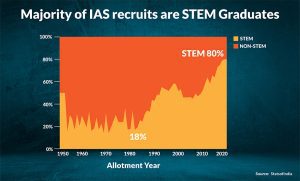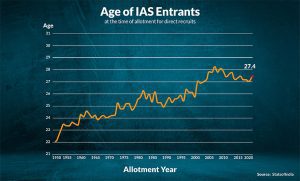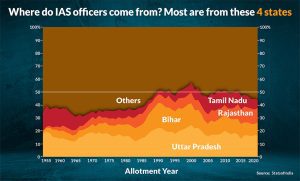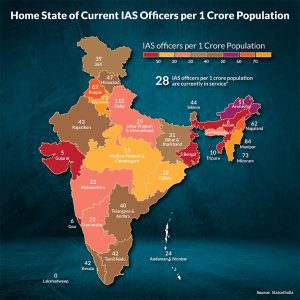
Today's average IAS entrant is older, more likely to be a STEM graduate: Data
In the sphere of civil services, it’s not just the gender mix that has changed over the decades; there have been changes in the age of entry of IAS officers, their graduation subjects, and so on

The Union Public Service Commission (UPSC) announced on Monday, May 30, that women candidates Shruti Sharma, Ankita Agarwal and Gamini Singla had landed the top three ranks in the 2021 civil services examination.
While that does speak volumes about women’s advancement in the civil services field, the fact remains that they still constitute just a quarter of the overall candidates who made it. Of the 685 candidates who qualified, 508 were men and 177 were women, said the UPSC. Interestingly, of the top 25 candidates, 15 were men and 10, women.
Also read: Stadiums to stay open till 10 pm: Delhi govt after track is ’emptied’ for IAS officer, dog
The civil services examination is conducted annually by the UPSC in three stages – preliminary, main and interview – to select officers of the Indian Administrative Service (IAS), Indian Foreign Service (IFS) and the Indian Police Service (IPS), among others.
Increasing move to STEM
In the sphere of civil services, it’s not just the gender mix that has changed over the decades. According to data available on the StatsofIndia website, down the years, there have been changes in the age of entry of IAS officers, their graduation subjects, and so on.

Take the graduation subject. This year’s topper Sharma graduated in History (Hons) from the University of Delhi while Agarwal graduated in Economics (Hons) from the same university. Singla holds a BTech in computer science, which is part of a larger trend – a substantial percentage of IAS officers today are STEM graduates.
StatsofIndia data reveal that in 1980, just 18 per cent of recruits were STEM (science, technology, engineering and mathematics) graduates (here, STEM includes MBBS, too). By 2020, the figure had risen to 80 per cent. This belies the conventional wisdom that humanities subjects such as history, economics and political science are IAS-friendly. It’s STEM graduates who’re swarming the civil services.
Also read: Nagaland women shine in all spheres, but find little space in politics
Gradual rise in entry age
There have been ups and downs in the average age of IAS entrants. However, over the period from 1950 to 2020, there is a remarkable rise in the entry age. From 22 years in 1950, it moved to around 24.5 in the 1960s, 25+ in the 1970s and 26+ in the early 1980s.

The entry age reached around 27 in the year 2000 and moved up to 28+ in 2005. By 2020, the average entry age stood at 27.4.
This could be indicative of the fact that, down the decades, IAS aspirants have opted to complete their education, work for a while and then take up the UPSC, rather than do it right out of college.
Four states account for most entrants
Down the decades, most IAS recruits have been residents of four states – Uttar Pradesh, Bihar, Rajasthan and Tamil Nadu.

Per StatsofIndia data, from the late 1980s to 2015, 50 per cent of IAS officers came from these four states. In 2000, in fact, UP, Bihar and Rajasthan alone accounted for 50 per cent of IAS officers, the data revealed.
Since then, however, Bihar slowed down, while Rajasthan and Tamil Nadu picked up.
‘Density’ of IAS officers
At present, India has about 28 serving IAS officers per 1 crore population.

The highest ‘density’ of IAS officers is in Delhi, which sent 115 officers. This is followed by Manipur, at 84, and Mizoram and Haryana, at 73 each.
Other states with high densities of IAS officers are Punjab, Nagaland, Arunachal Pradesh, Rajasthan, Telangana-Andhra Pradesh, Tamil Nadu and Kerala.
Uttar Pradesh and Bihar, which send a huge number of IAS officers, have a relatively low density of around 30 officers per 1 crore population.
Gujarat, West Bengal and Assam sent just around 5 officers per 1 crore population.

